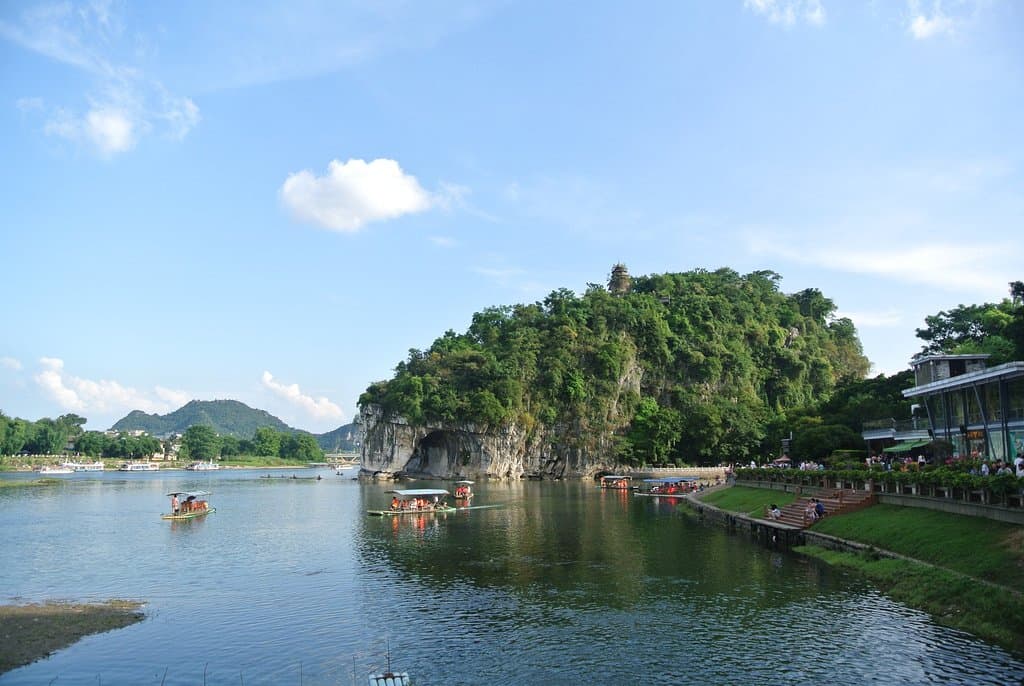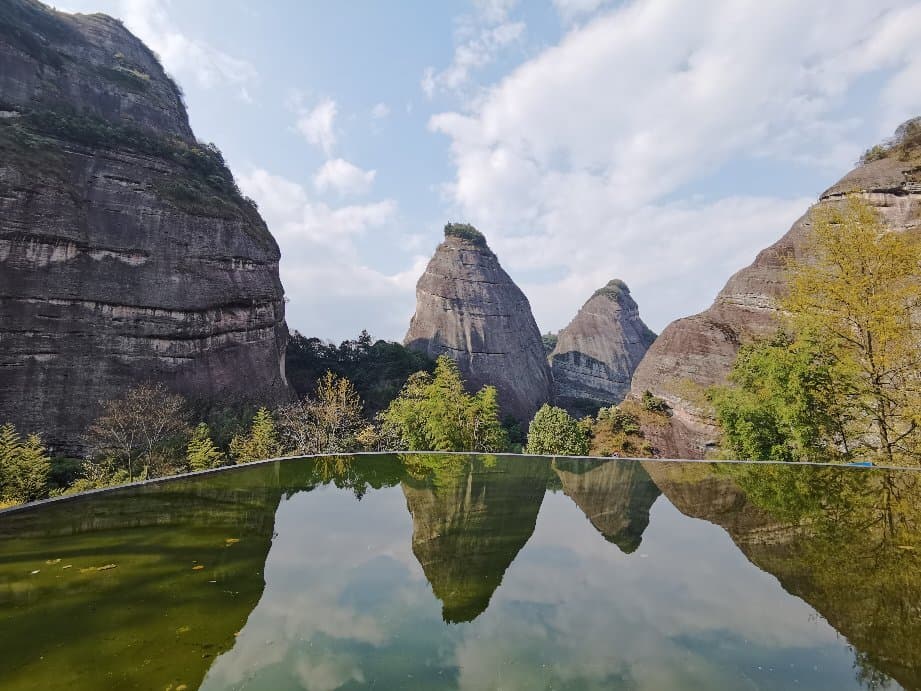Chengyang Wind and Rain Bridge
A stunning 1912 wooden Wind and Rain Bridge, a masterpiece of Dong ethnic craftsmanship, offering cultural immersion and scenic beauty.
Highlights
Must-see attractions

Social
From TikTok & Reddit
Best Time
Avoid midday sun
Chengyang Wind and Rain Bridge
Best Time
Avoid midday sun
Highlights
Must-see attractions
A stunning 1912 wooden Wind and Rain Bridge, a masterpiece of Dong ethnic craftsmanship, offering cultural immersion and scenic beauty.
"Must-see countryside in China - no tourist hordes around!"
📸 Capture the Details
The bridge's intricate joinery is a marvel; get close to appreciate the nail-free construction.
☀️ Sun Protection is Key
Bring a hat and parasol, especially in summer, as village areas offer little shade.
Highlights
Discover the most iconic attractions and experiences
The Wind and Rain Bridge Itself
Linxi River
A stunning 1912 wooden structure with five pagoda towers, built entirely without nails using traditional Dong techniques.
Dong Ethnic Village Life
Surrounding Chengyang Village
Immerse yourself in the quiet, majestic atmosphere of the ethnic minority village and observe local life.
Scenic River Views
From the bridge
Enjoy beautiful vistas of the Linxi River and the surrounding terraced landscapes.
Plans like a pro.
Thinks like you
Planning Your Visit
Embrace the Dong Culture
Prepare for the Elements
Best Times
Insider Tips
from TikTok, Instagram & Reddit
📸 Capture the Details
The bridge's intricate joinery is a marvel; get close to appreciate the nail-free construction.
☀️ Sun Protection is Key
Bring a hat and parasol, especially in summer, as village areas offer little shade.
🚶♀️ Explore Beyond the Bridge
Take the adjacent bridge to enter the village and experience local life.
🛍️ Souvenir Stalls
Lively vendors sell souvenirs on the bridge, adding to the vibrant atmosphere.
Tips
from all over the internet
📸 Capture the Details
The bridge's intricate joinery is a marvel; get close to appreciate the nail-free construction.
☀️ Sun Protection is Key
Bring a hat and parasol, especially in summer, as village areas offer little shade.
🚶♀️ Explore Beyond the Bridge
Take the adjacent bridge to enter the village and experience local life.
🛍️ Souvenir Stalls
Lively vendors sell souvenirs on the bridge, adding to the vibrant atmosphere.
What Travellers Say
Reviews Summary
Visitors rave about the Chengyang Wind and Rain Bridge as a must-see countryside gem with minimal tourist crowds, praising its unique Dong ethnic architecture and the serene beauty of the surrounding landscape. Some note the presence of souvenir vendors and the need for sun protection in exposed village areas.
"Must-see countryside in China - no tourist hordes around!"
Nicholas McLaughlin
"Year built: 1912 (late Qing Dynasty of China).
Type: Traditional “Wind and Rain Bridge” made of wood and stone.
Length: about 64.4 meters
Width: 3.4 meters
Height: about 10 meters
Located over the Linxi River.
---
🏯 Architectural features
A unique combination of bridge + temple + walkway.
There are 5 beautiful pagoda towers on the bridge.
The bridge is supported by 19 stone pillars and a wooden structure.
It was built completely without nails using the traditional Dong craftsmanship.
It is called the Wind and Rain Bridge because it is “a place where people can stay even when the wind and rain come.”
---
🌏 Cultural significance
It is considered a symbol of the traditional lifestyle, craftsmanship, and social life of the Dong ethnic group.
Villagers gather here to talk, relax, and hold festivals.
A National Cultural Heritage site of China.
---
✨ Special Features
The scenic views of the Linxi River are beautiful from the top of the bridge.
It is considered a must-see destination for tourists in Guangxi Province.
It is known as one of the most beautiful Wind and Rain Bridges in the world."
கன்னியாகுமரி மீனவன்
"Chengyang Bridge is the most famous of the many wind and rain bridges in the Zhuang area of Guangxi. The entire bridge does not require a single nail or rivet, but is made up of large and small strips of wood and hewn wood, connected by tenons. Today, Chengyang Bridge has become a national key cultural relic protection unit.
Tourists can only watch and take photos from a distance, and then take the bridge next to it to enter the village. There are a bunch of vendors selling souvenirs on the wall, which is very lively!
However, most of the village areas have no shelter. It is recommended to go there in summer and bring a parasol and hat to avoid sunburn!"
WAN JOU HO
What People Like
What People Dislike
Frequently Asked Questions
🚇 🗺️ Getting There
The bridge is located in Sanjiang Dong Autonomous County, Liuzhou City, Guangxi. Travelers often reach Liuzhou by train or plane and then take local transport, such as buses or taxis, to Sanjiang County and then to the bridge.
Once in Sanjiang County, local buses and taxis are available to take you to the Chengyang Wind and Rain Bridge. It's a well-known landmark, so drivers will be familiar with it.
You can take a long-distance bus from Liuzhou Bus Station to Sanjiang County, which takes a few hours. From Sanjiang, you can hire a taxi or take a local bus to the bridge.
Many visitors arrive via Liuzhou and then head to Sanjiang. The journey offers scenic views of the Guangxi countryside.
Yes, driving is possible, and there is usually parking available near the bridge. However, be prepared for potentially narrow rural roads.
🎫 🎫 Tickets & Entry
While the bridge itself is a national cultural heritage site, there might be a small entrance fee for the surrounding scenic area or village. It's advisable to check locally upon arrival.
The bridge is generally accessible throughout the day and night, as it's a functional part of the village. However, visitor centers or specific facilities might have set hours.
Information on admission fees can vary. Some sources suggest it's free to walk across, while others mention a fee for the broader scenic area.
The bridge is a public space and can be visited at any time. However, visiting during daylight hours is recommended for better sightseeing and photography.
Generally, visitors are expected to respect the cultural heritage and local customs. Avoid littering and be mindful of residents.
📸 📸 Photography
Capture the bridge from the riverbanks for a full view, from the adjacent bridge for a unique perspective, and from within the bridge itself to highlight its architecture.
Yes, the area is known for its clear skies, offering excellent opportunities for astrophotography, including the Milky Way.
Golden hours (early morning and late afternoon) offer beautiful light. Summer mornings are good to avoid harsh sun.
Generally, photography is allowed, but be respectful of the local residents and their privacy.
A wide-angle lens is useful for capturing the entire bridge and surrounding landscape. A tripod is highly recommended for night photography.
🎫 🏞️ Onsite Experience
Walk across the bridge, admire the Dong architecture, interact with local vendors, and explore the surrounding ethnic village.
Yes, you can take the bridge next to the main one to enter the village and experience the local lifestyle.
It's a symbol of the Dong ethnic group's traditional lifestyle, craftsmanship, and social life, serving as a gathering place.
While it's a popular spot, it's often described as having fewer tourist hordes compared to major attractions, offering a more authentic experience.
Comfortable walking shoes are essential. Consider light clothing and sun protection, especially during warmer months.
🍽️ 🍽️ Food & Dining
You'll find vendors selling souvenirs and local snacks on the bridge itself. For more substantial meals, explore the nearby village or Sanjiang County.
Look for local Dong specialties. If you have the chance, experiencing 'Youcha' (a type of tea) with villagers is a unique cultural activity.
Options might be limited, but basic rice and vegetable dishes are usually available in local eateries. It's best to inquire locally.
Food prices in the village are generally affordable, reflecting local costs. Dining in Sanjiang County might offer more variety and potentially higher prices.
Yes, souvenir vendors on the bridge often sell bottled water and small snacks.
For Different Travelers
Tailored advice for your travel style
👨👩👧 Families with Kids
Pack plenty of water and sun protection, especially during warmer months, as shade can be limited outside the bridge. Comfortable walking shoes are a must for navigating the bridge and village paths. Consider bringing a small notebook for kids to sketch what they see, turning the visit into an educational adventure.
📸 Photography Enthusiasts
Don't miss the chance for astrophotography; the clear night skies here are perfect for capturing the Milky Way. Bring a wide-angle lens to encompass the entire structure and its scenic surroundings, and a tripod is essential for low-light and night shots. The golden hours of sunrise and sunset provide beautiful, soft light for your images.
🚶♀️ Culture & History Buffs
Delve into the cultural significance of the bridge as a communal gathering space and a symbol of Dong traditions. Explore the adjacent village to gain deeper insights into their way of life. This is an opportunity to witness a living tradition and appreciate the historical context of this unique architectural marvel.
Deep Dives
In-depth insights and expert knowledge
The Marvel of Dong Woodcraftsmanship
The bridge's design is not just functional but also aesthetically pleasing, featuring five ornate pagoda towers that punctuate its length. These towers, along with the covered walkways and benches, provide shelter from the elements, hence its name: 'Wind and Rain Bridge.' It serves as a vital communal space where villagers gather to socialize, relax, and conduct daily life, embodying the cultural significance of the Dong people.
Visiting the bridge offers a unique opportunity to witness this living heritage. The craftsmanship is evident in every joint and beam, showcasing a deep understanding of natural materials and construction principles. It's a UNESCO-recognized site and a symbol of the enduring traditions of the Dong minority.
Experiencing the Local Culture
Adjacent to the bridge lies the Chengyang village, which offers a glimpse into the daily lives of the Dong people. Visitors are encouraged to explore the village, observe their traditional housing, and perhaps even interact with residents. Some travelers have mentioned the opportunity to join villagers in making Youcha tea, a unique cultural experience that includes local singing and dancing.
While the bridge area has souvenir vendors, venturing into the village provides a more authentic cultural immersion. Remember to be respectful of local customs and privacy as you explore. The quiet, majestic atmosphere of the village, set against the backdrop of rice terraces and rolling hills, offers a peaceful and enriching experience.


Social
from TikTok, Instagram & Reddit